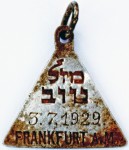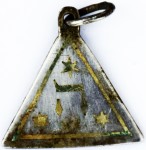 Archaeologists have discovered a rare and poignant pendant that belonged to a teen girl with a possible connection to Anne Frank in an excavation of the site of the Sobibor death camp. The camp, which was razed to the ground by the Nazis after a daring uprising in October 1943 which saw half the prisoners escape, has been excavated since 2007. Past digs have unearthed the foundations of the gas chambers, the train station platform and a myriad small artifacts, the treasured belongings of Sobibor’s victims.
Archaeologists have discovered a rare and poignant pendant that belonged to a teen girl with a possible connection to Anne Frank in an excavation of the site of the Sobibor death camp. The camp, which was razed to the ground by the Nazis after a daring uprising in October 1943 which saw half the prisoners escape, has been excavated since 2007. Past digs have unearthed the foundations of the gas chambers, the train station platform and a myriad small artifacts, the treasured belongings of Sobibor’s victims.
 This year the brief was to excavate the site of where female prisoners were made to strip naked and had their heads shaved before being forced down the “Road to Heaven,” ie, the path to the gas chambers 40 meters (130 feet) south of the undressing and shaving hut. Close to what had once been the entrance of the building, the team discovered some small personal items that probably fell through the floorboards onto the foundations. They include a lady’s watch, a stone pendant, a Star of David necklace and a metal locket covered with glass and painted with a depiction of Moses holding the Ten Commandments on the front the Jewish prayer “Shema” on the back.
This year the brief was to excavate the site of where female prisoners were made to strip naked and had their heads shaved before being forced down the “Road to Heaven,” ie, the path to the gas chambers 40 meters (130 feet) south of the undressing and shaving hut. Close to what had once been the entrance of the building, the team discovered some small personal items that probably fell through the floorboards onto the foundations. They include a lady’s watch, a stone pendant, a Star of David necklace and a metal locket covered with glass and painted with a depiction of Moses holding the Ten Commandments on the front the Jewish prayer “Shema” on the back.
 One of those artifacts is a little triangular pendant. On one side is engraved the phrase “Mazel Tov” in Hebrew, the city “Frankfurt am Main” in German and the date July 3, 1929. The other side has the Hebrew letter “ה” (“He”), used to symbolize the name of God (“He” stands for “Hashem”, which means “The Name,” so it’s a way of referring to God without using His name), and three Stars of David. It’s very difficult to connect an artifact with one individual of hundreds of thousands of camp victims, the date and city gave researchers a rare opportunity. Yad Vashem researchers were able to pinpoint exactly one person who fit the parameters of the pendant: Karoline Cohn, born in Frankfurt on July 3, 1929, and deported to the Minsk ghetto in November of 1941.
One of those artifacts is a little triangular pendant. On one side is engraved the phrase “Mazel Tov” in Hebrew, the city “Frankfurt am Main” in German and the date July 3, 1929. The other side has the Hebrew letter “ה” (“He”), used to symbolize the name of God (“He” stands for “Hashem”, which means “The Name,” so it’s a way of referring to God without using His name), and three Stars of David. It’s very difficult to connect an artifact with one individual of hundreds of thousands of camp victims, the date and city gave researchers a rare opportunity. Yad Vashem researchers were able to pinpoint exactly one person who fit the parameters of the pendant: Karoline Cohn, born in Frankfurt on July 3, 1929, and deported to the Minsk ghetto in November of 1941.
 Buoyed by their early military successes in Soviet territories, in October of 1941 the Nazi command began a program of deportations, removing Jews from the Third Reich (Germany, Austria, Bohemia, Moravia) to freshly conquered cities in Eastern Europe. The deportations continued through 1945, targeting big cities which had the largest concentrations of Jews. Frankfurt had the highest percentage of Jews in pre-war Germany (4.7% of the population in 1933, as opposed to Berlin’s 3.8%), so it was a priority. In the less than four years between 1941 and 1945, 10,600 Frankfurt Jews were sent east to concentration camps in 25 deportations. Fewer than 600 Jews from Frankfurt survived the Holocaust, and only nine of the Jews deported from Frankfurt to Minsk lived to see the end of the war.
Buoyed by their early military successes in Soviet territories, in October of 1941 the Nazi command began a program of deportations, removing Jews from the Third Reich (Germany, Austria, Bohemia, Moravia) to freshly conquered cities in Eastern Europe. The deportations continued through 1945, targeting big cities which had the largest concentrations of Jews. Frankfurt had the highest percentage of Jews in pre-war Germany (4.7% of the population in 1933, as opposed to Berlin’s 3.8%), so it was a priority. In the less than four years between 1941 and 1945, 10,600 Frankfurt Jews were sent east to concentration camps in 25 deportations. Fewer than 600 Jews from Frankfurt survived the Holocaust, and only nine of the Jews deported from Frankfurt to Minsk lived to see the end of the war.
Karoline Cohn was not one of them. When the Minsk ghetto was liquidated in September of 1943, the 2,000 Jews still living were shipped to almost certain death in Sobibor. Either she or someone else carried her pendant to the camp where it fell through the floorboards of the shaving hut only to be found 70 years later.
In a historical fluke of almost unbelievable proportions, Anne Frank had a pendant exactly like it. The only difference is the dates on the front of the pendants. Anne’s was June 12th, 1929. No other such medallions have been found — before the Sobibor discovery, Anne’s was the only one of its kind known, saved by her cousin Buddy Elias — so they weren’t something produced en masse and widely distributed. Anne was also born in Frankfurt just three weeks before Karoline.
Yad Vashem is reaching out to any surviving family members of the Cohns and Franks in the hope they might be able to establish a clear connection, familial or otherwise. Researchers ask that relatives or members of the public who know anything at all about Karoline or about Sophie Kollmann, who in April 1978 wrote Pages of Testimony about Richard Else Cohn and Karoline Cohn, to contact Yoram Haimi at yoramhi@israntique.org.il.